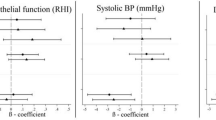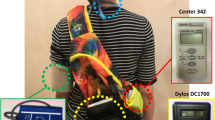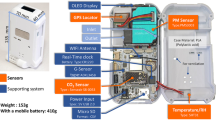Abstract
Studies have linked increased levels of particulate air pollution to decreased autonomic control, as measured by heart rate variability (HRV), particularly in susceptible populations such as the elderly. In this study, we use data obtained from the 1998 USEPA epidemiology-exposure longitudinal panel study of elderly adults in a Baltimore retirement home to examine the relationship between HRV and PM2.5 personal exposure. We consider PM2.5 personal exposure in the aggregate and personal exposure to the components of PM2.5 as estimated in two ways using receptor models. We develop a Bayesian hierarchical model for HRV as a function of personal exposure to PM2.5, which integrates HRV measurements and data obtained from personal, indoor and outdoor PM2.5 monitoring and meteorological data. We found a strong relationship between decreased HRV (HF, LF, r-MSSD and SDNN) and total personal exposure to PM2.5 at a lag of 1 day. Using personal exposure monitoring (PEM) apportionment results, we examined the relative importance of ambient and non-ambient personal PM2.5 exposure to HRV and found the effect of internal non-ambient sources of PM2.5 on HRV to be minimal. Using the PEM apportionment data, a consistent effect of soil at short time scales (lag 0) was found across all five HRV measures, and an effect of sulfate on HRV was seen for HF and r-MSSD at the moving average of lags 0 and 1 days. Modeling of ambient site apportionment data indicated effects of nitrate on HRV at lags of 1 day, and moving averages of days 0 and 1 and days 0–2 for all but the ratio LF/HF. Sulfate had an effect on HRV at a lag of 1 day for four HRV measures (HF, LF, r-MSSD, SDNN) and for LF/HF at a moving average of days 0–2.
This is a preview of subscription content, access via your institution
Access options
Subscribe to this journal
Receive 6 print issues and online access
$259.00 per year
only $43.17 per issue
Buy this article
- Purchase on Springer Link
- Instant access to full article PDF
Prices may be subject to local taxes which are calculated during checkout






Similar content being viewed by others
References
Cavallari J., Fang S., Eisen E., Schwartz J., Hauser R., Herrick R., and Christiani D. Time course of heart rate variability decline following particulate matter exposures in an occupational cohort. Inhal Tox 2008: 20 (4): 415–422.
Creason J., Neas L., Walsh D., Williams R., Sheldon L., Liao D., and Shy C. Particulate matter and heart rate variability among elderly retirees: the Baltimore 1998 PM study. J Expo Anal Environ Epidemiol 2001: 11: 1–7.
Dekker J., Schouten E., Klootwijk P., Pool J., Swenne C., and Kromhout D. Heart rate variability from short electrocardiographic recordings predicts mortality from all causes in middle-aged and elderly men: the Zutphen Study. Am J Epidemiol 1997: 145: 899–908.
Devlin R.B., Ghio A.J., Kehrl H., Sanders G., and Cascio W. Elderly humans exposed to concentrated air pollution particles have decreased heart rate variability. Eur Respir J 2003: 21 (40): 76s–80s.
Diggle P. An approach to the analysis of repeated measurements. Biometrics 1988: 44 (17): 959–971.
Dockery D. Epidemiologic evidence of cardiovascular effects of particulate air pollution. Environ Health Perspect 2001: 109: 483–486.
Dockery D., Pope C., Xu X., Spengler J., Ware J., Fay M., Ferris B., and Speizer F. An association between air pollution and mortality in six US cities. New Engl J Med 1993: 329: 1753–1759.
Finlayson-Pitts B., and Pitts J. Chemistry of the Upper and Lower Atmosphere: Theory, Experiments and Applications. Academic Press, Inc., San Diego, CA, 1999.
Gelman A. Prior distributions for variance parameters in hierarchical models. Bayesian Anal 2006: 1: 515–533.
Gelman A., Carlin J.B., Stern H.S., and Rubin D.B. Bayesian Data Analysis, 2nd edn. Chapman and Hall, New York, NY, 2003.
Gelman A., and Hill J. Data Analysis using Regression and Multilevel/Hierarchical Models. Cambridge University Press, New York, NY, 2007.
Godleski J., Verrier R., Koutrakis P., and Catalano P. Mechanisms of Morbidity and Mortality from Exposure to Ambient Air Particles. Tech. Rep. 91, Health Effects Institute, Cambridge, MA, 2000.
Hastie T., and Tibshirani R. Generalized Additive Models. Chapman and Hall, New York, NY, 1990.
Holloman C., Bortnik S., Morara M., Strauss W., and Calder C. A Bayesian hierarchical approach for relating PM2.5 exposure to cardiovascular mortality in North Carolina. Environ Health Perspect 2004: 112: 1282–1288.
Hopke P.K., Ramadan Z., Paatero P., Norris G.A., Landis M.S., Williams R.W., and Lewis C.W. Receptor modeling of ambient and personal exposure samples: the 1998 Baltimore Particulate Matter Epidemiology-Exposure Study. Atmos Environ 2003: 37: 3289–3302.
Huang Y., Dominici F., and Bell M. Bayesian hierarchical distributed lag models for summer ozone exposure and cardio-respiratory mortality. Environmetrics 2005: 16: 547–562.
Jones G., Haran M., Caffo B., and Neath R. Fixed-width output analysis for Markov Chain Monte Carlo. J Am Stat Assoc 2006: 101: 1537–1547.
La Rovere M., Bigger J., Marcus F., Mortara A., and Schwartz P. Baroreflex sensitivity and heart-rate variability in prediction of total cardiac mortality after myocardial infarction. Lancet 1998: 351: 478–484.
Laden F., Neas L., Dockery D., and Schwartz J. Association of fine particulate matter from different sources with daily mortality in six US cities. Environ Health Perspect 2000: 108: 941–947.
Landis M.S., Norris G.A., Williams R.W., and Weinstein J.P. Personal exposures to PM2.5 mass and trace elements in Baltimore, MD, USA. Atmos Environ 2001: 35: 6511–6524.
Liao D., Creason J., Shy C., Williams R., Watts R., and Zweidinger R. Daily variation of particulate air pollution and poor cardiac autonomic control in the elderly. Environ Health Perspect 1999: 107: 521–525.
Luttman-Gibson H., Coull B.A., Dockery D.W., Ebelt S.T., Schwartz J., Stone P.H., Suh H.H., and Gold D.R. Short-term effects of air pollution on heart rate variability in senior adults in Steubenville, Ohio. J Occup Environ Med 2006: 48 (8): 780–788.
Magari S.R., Hauser R., Schwartz J., Williams P.L., Smith T.J., and Christiani D.C. Association of heart rate variability with occupational and environmental exposure to particulate air pollution. Circulation 2001: 104: 986–991.
Mar T., Ito K., Koenig J., Larson T.V., Eatough D.J., Henry R.C., Kim E., Laden F., Lall R., Neas L., Stolzel M., Paatero P., Hopke P.K., and Thurston G.D. PM source apportionment and health effects. 3. Investigation of inter-method variations in associations between estimated source contributions of PM2.5 and daily mortality in Phoenix, AZ. J Expo Anal Environ Epidemiol 2006: 16: 311–320.
McBride S., Williams R., and Creason J. Bayesian hierarchical modeling of personal exposure to particulate matter. Atmos Environ 2007: 41: 6143–6155.
Nikolov M.C., Coull B.A., Catalano P.J., and Godleski J.J. An informative Bayesian structural equation model to assess source-specific health effects of air pollution. Biostatistics 2007: 8: 609–624.
Ntzoufras I. Bayesian Modeling using WinBUGS. John Wiley & Sons, New York, NY, 2009.
O’Neill M., Zanobetti A., and Schwartz J. Modiers of the temperature and mortality association in seven US cities. Am J Epidemiol 2003: 157: 1074–1082.
Özkaynak H., Xue J., Spengler J., Wallace L., Pellizzari E., and Jenkins P. Personal exposure to airborne particles and metals: results from the Particle PTEAM study in Riverside, California. J Expo Anal Environ Epidemiol 1996: 6: 57–78.
Paatero P. A weighted non-negative least squares algorithm for three-way PARAFAC factor analysis. Chemometr Intell Lab 1997: 37: 223–242.
Paatero P. The multilinear engine—a table-driven least squares program for solving multilinear problems including the n-way parallel factor analysis model. J Comput Graph Stat 1999: 8: 854–888.
Park S.K., O’Neill M.S., Vokonas P.S., Sparrow D., and Schwartz J. Effects of air pollution on heart rate variability: the VA Normative Aging Study. Environ Health Perspect 2005: 113: 304–309.
Pope C.A., Hansen M.L., Long R.W., Nielsen K.R., Eatough N.L., Wilson W.E., and Eatough D.J. Ambient particulate air pollution, heart rate variability, and blood markers of inflammation in a panel of elderly subjects. Environ Health Perspect 2004: 112 (3): 339–345.
Richardson S., and Best N. Bayesian hierarchical models in ecological studies of health environment effects. Environmetrics 2003: 14: 129–147.
Sarnat J.A., Marmur A., Klein M., Kim E., Russell A.G., Sarnat S.E., Mulholland J.A., Hopke P.K., and Tolbert P.E. Fine particle sources and cardiorespiratory morbidity: an application of chemical mass balance and factor analytical source-apportionment methods. Environ Health Perspect 2008: 116: 459–466.
Spiegelhalter D., Thomas A., Best N., and Lunn D. WinBUGS Version 1.4.1, MRC Biostatistics Unit, Institute of Public Health, Cambridge, UK. http://www.mrcbsu.cam.ac.uk/bugs, 2003.
Strand M., Vedal S., Rodes C., Dutton S., Gelfand E., and Rabinovitch N. Estimating effects of ambient PM2.5 exposure on health using PM2.5 component measurements and regression calibration. J Expo Sci Environ Epidemiol 2006: 16: 30–38.
Wallace L., and Williams R. Use of personal-indoor-outdoor sulfur concentrations to estimate the infiltration factor and outdoor exposure factor for individual homes and persons. Environ Sci Technol 2005: 39 (6): 1707–1714.
Wallace W., Williams R., Suggs J., and Jones P. Estimating Contributions of Outdoor Fine Particles to Indoor Concentrations and Personal Exposures: Effects of Household Characteristics and Personal Activities. Tech. Rep. ORD Report (APM214), EPA/600/R-023, US Environmental Protection Agency, Washington, DC, 2006.
Williams R., Suggs J., Creason J., Rodes C., Lawless P., Kwok R., Zweidinger R., and Sheldon L. The 1998 Baltimore particulate matter epidemiology-exposure study: part 2. Personal exposure assessment associated with an elderly study population. J Expo Anal Environ Epidemiol 2000a: 10: 533–543.
Williams R., Suggs J., Zweidinger R., Evans G., Creason J., Kwok R., Rodes C., Lawless P., and Sheldon L. The 1998 Baltimore particulate matter epidemiology-exposure study: part 1. Comparison of ambient, residential outdoor, indoor and apartment particulate matter monitoring. J Expo Anal Environ Epidemiol 2000b: 10: 518–532.
Wilson W.E., and Brauer M. Estimation of ambient and non-ambient components of particulate matter exposure from a personal monitoring panel study. J Expo Sci Environ Epidemiol 2006: 16: 264–274.
Acknowledgements
We thank John Creason (USEPA) and Debra Walsh (USEPA) for their assistance with health measures data, as well as Charles Rodes and the staff of RTI International for their collection of field exposure data. The authors thank the reviewer for insightful comments on the manuscript.
Author information
Authors and Affiliations
Corresponding author
Ethics declarations
Competing interests
The authors declare no conflict of interest.
Additional information
Disclaimer
This paper is now being subjected to external peer review and has not been cleared for publication by the US Environmental Protection Agency. The US Environmental Protection Agency through its Office of Research and Development funded and conducted the research described herein through contract 3D-5925-WATX and 4D-5895-WATX to Dr. Sandra McBride. Mention of trade names or commercial products does not constitute endorsement or recommendation for use.
Appendix A
Appendix A
WinBUGS code
model;
{
## model for first 119 obs with both HRV and PM personal mmts
## separate loop for first observation since this is a lag 1 model and
## an observation at time 0 is not available; see defn of errorfirst.
for (obsnum in 1:1){
## measurement error model for observed HRV observations
Z[obsnum]∼dnorm(H[obsnum],tau.H);
## regression equation for unknown HRV
H[obsnum] <- beta[Person[obsnum]]+Hcoef[1]+Hcoef[2]*age[obsnum]+Hcoef[3]*cvcompro[obsnum]+Hcoef[4]*sex[obsnum]+Hcoef[5]*M.P.tot.lag1[obsnum]+Tcoef[1]*a.temp1[day.num[obsnum]]+Tcoef[2]*a.temp2[day.num[obsnum]]+Tcoef[3]* a.temp3[day.num[obsnum]]+Tcoef[4]*a.temp4[day.num[obsnum]]+error[obsnum];
## first observation of error is set to be random and is the same for all individuals
error[obsnum]<-errorfirst;
## measurement error model for observed PM2.5
Y.P.lag1[obsnum]∼dnorm(M.P.tot.lag1[obsnum],tau.M.P.tot);
## unknown total personal PM2.5 exposure as sum of ambient and
## non-ambient components
M.P.tot.lag1[obsnum]<-M.P.NA.lag1+M.P.A.lag1[obsnum];
## unknown personal PM2.5 of ambient origin as product of infiltration
## and unknown ambient PM2.5
M.P.A.lag1[obsnum]<-gamma1*PMC[day.num[obsnum]];
}
## loop for remaining 118 observations for which both HRV and PM2.5 are
## available (same code as above except for defn of “error[obsnum]”)
for (obsnum in 2:119){
Z[obsnum]∼dnorm(H[obsnum],tau.H);
H[obsnum] <- beta[Person[obsnum]]+Hcoef[1]+Hcoef[2]*age[obsnum]+Hcoef[3]*cvcompro[obsnum]+Hcoef[4]*sex[obsnum]+Hcoef[5]*M.P.tot.lag1[obsnum]+Tcoef[1]*a.temp1[day.num[obsnum]]+Tcoef[2]*a.temp2[day.num[obsnum]]+Tcoef[3]*a.temp3[day.num[obsnum]]+Tcoef[4]*a.temp4[day.num[obsnum]]+error[obsnum];
##Definition of error term in terms of previous observations
##Indicator variable “Frst” indicates whether this observation
##is the first in the time series for a given individual.
error[obsnum]<-Frst[obsnum]*errorfirst+(1−Frst[obsnum])*(exp(−alpha*delta[obsnum])*error[obsnum-1]);
Y.P.lag1[obsnum]∼dnorm(M.P.tot.lag1[obsnum],tau.M.P.tot);
M.P.tot.lag1[obsnum]<-M.P.NA.lag1+M.P.A.lag1[obsnum];
M.P.A.lag1[obsnum]<-gamma1*PMC[day.num[obsnum]];
}
### model for remaining measurements with HRV only, no personal PM mmts
for (obsnum in 120:658){
Z[obsnum]∼dnorm(H[obsnum],tau.H);
H[obsnum] <- beta[Person[obsnum]]+Hcoef[1]+Hcoef[2]*age[obsnum]+Hcoef[3]*cvcompro[obsnum]+Hcoef[4]*sex[obsnum]+Hcoef[5]*M.P.tot.lag1[obsnum]+Tcoef[1]*a.temp1[day.num[obsnum]]+Tcoef[2]*a.temp2[day.num[obsnum]]+Tcoef[3]*a.temp3[day.num[obsnum]]+Tcoef[4]*a.temp4[day.num[obsnum]]+error[obsnum];
error[obsnum]<-Frst[obsnum]*errorfirst+(1−Frst[obsnum])*(exp(−alpha*delta[obsnum])*error[obsnum-1]);
M.P.tot.lag1[obsnum]<-M.P.NA.lag1+M.P.A.lag1[obsnum];
M.P.A.lag1[obsnum]<-gamma1*PMC[day.num[obsnum]];
}
## random subject-specific effect
for (i in 1:56){
beta[i]∼dnorm(0.0,tau.b);
}
## non-ambient PM2.5 personal
M.P.NA.lag1∼dnorm(mu.MPNA,tau.MPNA);
## personal sulfur measurements are X.Ind
## gamma1 is the infiltration factor
for (i in 1:N.sulfur){
X.Ind[i]∼dnorm(Sulfur.Ind[i],tau.meas.sulfurInd);
Sulfur.Ind[i]<-gamma1*SulfurC[day.num.sulfur[i]]+errgamma1;
}
## submodel for outdoor sulfur; mean is linear function of meteorology
## outdoor sulfur measurements are X.C
## separate models for day 1 and days 2–29 since for day 1
## a mean of sulfur at day 0 is needed; this is set to be random
for (t in 1:1){
X.C[t]∼dnorm(SulfurC[t],tau.meas.sulfurC);
SulfurC[t]∼dnorm(mu.sulfurC[t],tau.mean.sulfurC);
mu.sulfurC[t] <- Scoef[1]+Scoef[2]*humid[t]+Scoef[3]*humid.lag1[t]+Scoef[4]*vws[t]+Scoef[5]*vws.lag1[t]+Scoef[6]*temp[t]+Scoef[7]*temp.lag1[t]+rho.sulfurc*mu.sulfurc.t0+eps.sulfur;
}
for (t in 2:29){
X.C[t]∼dnorm(SulfurC[t],tau.meas.sulfurC);
SulfurC[t]∼dnorm(mu.sulfurC[t],tau.mean.sulfurC);
mu.sulfurC[t] <- Scoef[1]+Scoef[2]*humid[t]+Scoef[3]*humid.lag1[t]+Scoef[4]*vws[t]+Scoef[5]*vws.lag1[t]+Scoef[6]*temp[t]+Scoef[7]*temp.lag1[t]+rho.sulfurc*mu.sulfurC[t−1]+eps.sulfur;
}
## submodel for outdoor PM2.5 observations
## outdoor PM2.5 measurements are Y.C
for (t in 1:1){ ## for PM2.5
Y.C[t]∼dnorm(PMC[t],tau.meas.pmc);
PMC[t]∼dnorm(mu.pmc[t],tau.mean.pmc);
mu.pmc[t] <- PMCcoef[1]+PMCcoef[2]*humid[t]+PMCcoef[3]*humid.lag1[t]+PMCcoef[4]*vws[t]+PMCcoef[5]*vws.lag1[t]+PMCcoef[6]*dow[t]+ rho.pmc * mu.pmc.t0+eps.pmc;
}
for (t in 2:29){
Y.C[t]∼dnorm(PMC[t],tau.meas.pmc);
PMC[t]∼dnorm(mu.pmc[t],tau.mean.pmc);
mu.pmc[t] <- PMCcoef[1]+PMCcoef[2]*humid[t]+PMCcoef[3]*humid.lag1[t]+PMCcoef[4]*vws[t]+PMCcoef[5]*vws.lag1[t]+PMCcoef[6]*dow[t]+ rho.pmc * mu.pmc[t−1]+eps.pmc;
}
##############
### PRIORS ###
##############
## coefficients in regression equation for HRV
for (i in 1:5) {
Hcoef[i]∼dnorm(0.0,1.0E−2);
}
## error term in regression equation for HRV
alpha∼dunif(0.0,20.0);
tau.H <- pow(sigma.tau.H,−2);
sigma.tau.H∼dunif(0.0,100.0);
## scale parameter for random subject effect
tau.b <- pow(sigma.tau.b,−2);
sigma.tau.b∼dunif(0.0,100.0);
errorfirst∼dnorm(0,1.0E−2);
## coefficients in cubic splines for temperature
for (i in 1:4){
Tcoef[i]∼dnorm(0.0,1.0E−2);
}
## scale parameter for measured personal sulfur
tau.meas.sulfurInd<-pow(sigma.tau.meas.sulfurInd,−2);
sigma.tau.meas.sulfurInd∼dunif(0.0, 100.0);
## scale parameter for total personal PM2.5 exposure
tau.M.P.tot<-pow(sigma.tau.M.P.tot,−2);
sigma.tau.M.P.tot∼dunif(0.0, 100.0);
## parameters in non-ambient personal PM2.5 exposure
mu.MPNA∼dnorm(5.0,1.0E−2);
tau.MPNA<-pow(sigma.tau.MPNA,−2);
sigma.tau.MPNA∼dunif(0.0, 100.0);
## infiltration factor
gamma1∼dbeta(1.0,1.0);
errgamma1∼dnorm(0.0,1.0E−2);
## priors for terms in model for outdoor sulfur
eps.sulfur∼dnorm(0.0,1.0E−2);
rho.sulfurc∼dunif(−1,1);
mu.sulfurc.t0∼dnorm(2.3,1.0E−2);
for (i in 1:7){
Scoef[i]∼dnorm(0.0,1.0E−2);
}
tau.meas.sulfurC<-pow(sigma.tau.meas.sulfurC,−2);
sigma.tau.meas.sulfurC∼dunif(0.0,100.0);
tau.mean.sulfurC<-pow(sigma.tau.mean.sulfurC,−2);
sigma.tau.mean.sulfurC∼dunif(0.0, 100.0);
## priors for terms in model for outdoor PM2.5
eps.pmc∼dnorm(0.0,1.0E−2);
rho.pmc∼dunif(−1,1);
mu.pmc.t0∼dnorm(18,1.0E−2);
for (i in 1:6){
PMCcoef[i]∼dnorm(0.0, 1.0E−2);
}
tau.meas.pmc<-pow(sigma.tau.meas.pmc,−2);
sigma.tau.meas.pmc∼dunif(0.0,100.0);
tau.mean.pmc<-pow(sigma.tau.mean.pmc,−2);
sigma.tau.mean.pmc∼dunif(0.0,100.0);
}
Rights and permissions
About this article
Cite this article
Mcbride, S., Norris, G., Williams, R. et al. Bayesian hierarchical modeling of cardiac response to particulate matter exposure. J Expo Sci Environ Epidemiol 21, 74–91 (2011). https://doi.org/10.1038/jes.2009.58
Received:
Accepted:
Published:
Issue Date:
DOI: https://doi.org/10.1038/jes.2009.58
Keywords
This article is cited by
-
The mobile monitoring of black carbon and its association with roadside data in the Chinese megacity of Shanghai
Environmental Science and Pollution Research (2017)
-
Noninvasive effects measurements for air pollution human studies: methods, analysis, and implications
Journal of Exposure Science & Environmental Epidemiology (2015)
-
Structural equation modeling of parasympathetic and sympathetic response to traffic air pollution in a repeated measures study
Environmental Health (2013)
-
Structural equation modeling of the inflammatory response to traffic air pollution
Journal of Exposure Science & Environmental Epidemiology (2013)



